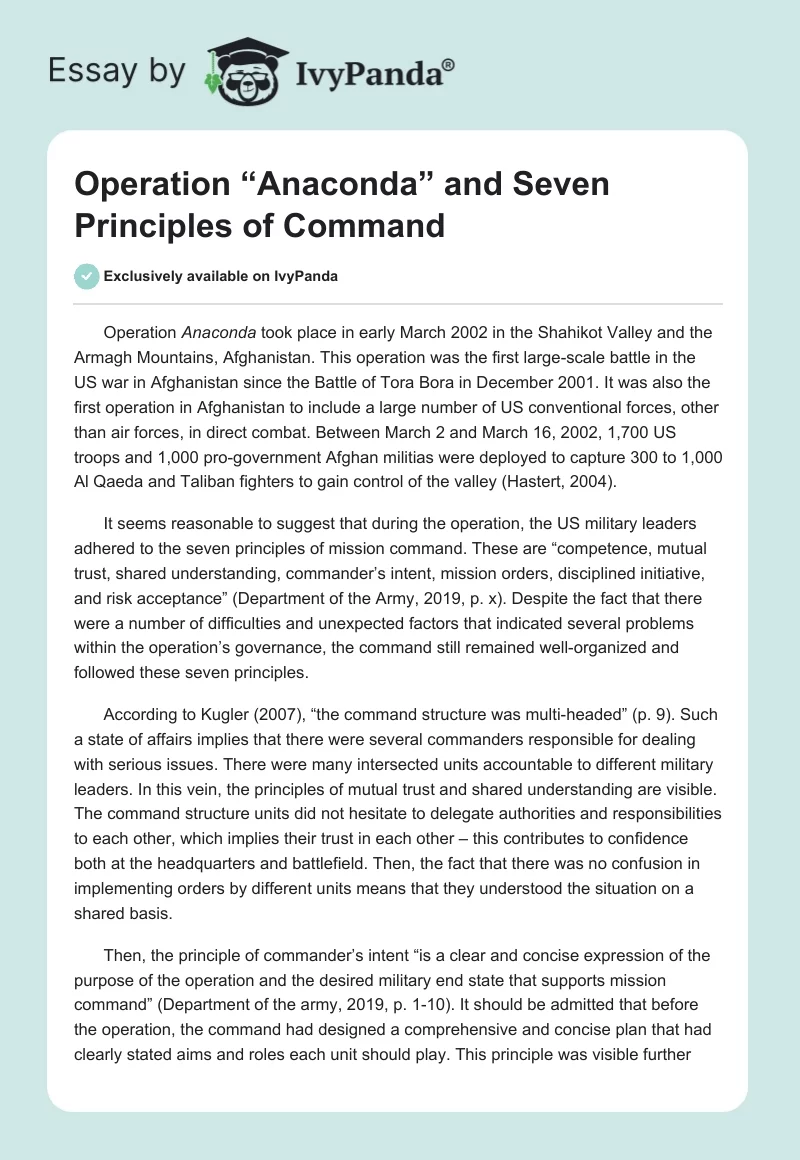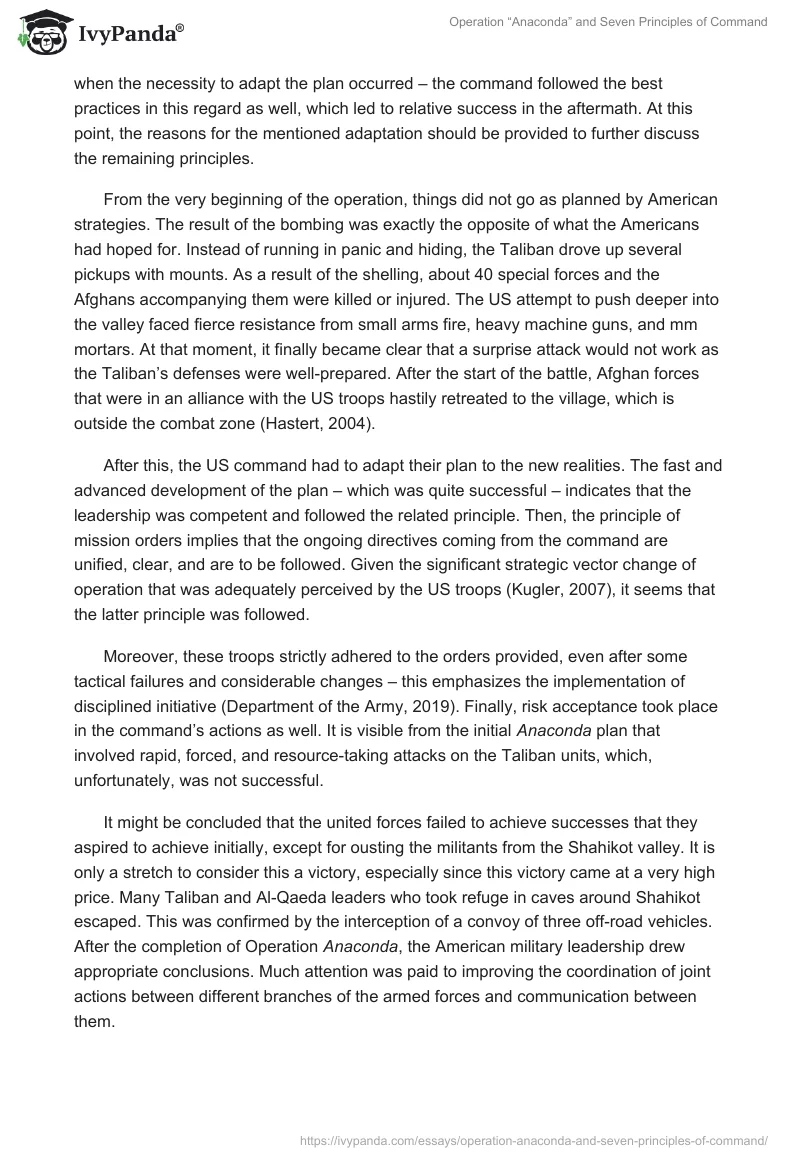Operation Anaconda took place in early March 2002 in the Shahikot Valley and the Armagh Mountains, Afghanistan. This operation was the first large-scale battle in the US war in Afghanistan since the Battle of Tora Bora in December 2001. It was also the first operation in Afghanistan to include a large number of US conventional forces, other than air forces, in direct combat. Between March 2 and March 16, 2002, 1,700 US troops and 1,000 pro-government Afghan militias were deployed to capture 300 to 1,000 Al Qaeda and Taliban fighters to gain control of the valley (Hastert, 2004).
It seems reasonable to suggest that during the operation, the US military leaders adhered to the seven principles of mission command. These are “competence, mutual trust, shared understanding, commander’s intent, mission orders, disciplined initiative, and risk acceptance” (Department of the Army, 2019, p. x). Despite the fact that there were a number of difficulties and unexpected factors that indicated several problems within the operation’s governance, the command still remained well-organized and followed these seven principles.
According to Kugler (2007), “the command structure was multi-headed” (p. 9). Such a state of affairs implies that there were several commanders responsible for dealing with serious issues. There were many intersected units accountable to different military leaders. In this vein, the principles of mutual trust and shared understanding are visible. The command structure units did not hesitate to delegate authorities and responsibilities to each other, which implies their trust in each other – this contributes to confidence both at the headquarters and battlefield. Then, the fact that there was no confusion in implementing orders by different units means that they understood the situation on a shared basis.
Then, the principle of commander’s intent “is a clear and concise expression of the purpose of the operation and the desired military end state that supports mission command” (Department of the army, 2019, p. 1-10). It should be admitted that before the operation, the command had designed a comprehensive and concise plan that had clearly stated aims and roles each unit should play. This principle was visible further when the necessity to adapt the plan occurred – the command followed the best practices in this regard as well, which led to relative success in the aftermath. At this point, the reasons for the mentioned adaptation should be provided to further discuss the remaining principles.
From the very beginning of the operation, things did not go as planned by American strategies. The result of the bombing was exactly the opposite of what the Americans had hoped for. Instead of running in panic and hiding, the Taliban drove up several pickups with mounts. As a result of the shelling, about 40 special forces and the Afghans accompanying them were killed or injured. The US attempt to push deeper into the valley faced fierce resistance from small arms fire, heavy machine guns, and mm mortars. At that moment, it finally became clear that a surprise attack would not work as the Taliban’s defenses were well-prepared. After the start of the battle, Afghan forces that were in an alliance with the US troops hastily retreated to the village, which is outside the combat zone (Hastert, 2004).
After this, the US command had to adapt their plan to the new realities. The fast and advanced development of the plan – which was quite successful – indicates that the leadership was competent and followed the related principle. Then, the principle of mission orders implies that the ongoing directives coming from the command are unified, clear, and are to be followed. Given the significant strategic vector change of operation that was adequately perceived by the US troops (Kugler, 2007), it seems that the latter principle was followed.
Moreover, these troops strictly adhered to the orders provided, even after some tactical failures and considerable changes – this emphasizes the implementation of disciplined initiative (Department of the Army, 2019). Finally, risk acceptance took place in the command’s actions as well. It is visible from the initial Anaconda plan that involved rapid, forced, and resource-taking attacks on the Taliban units, which, unfortunately, was not successful.
It might be concluded that the united forces failed to achieve successes that they aspired to achieve initially, except for ousting the militants from the Shahikot valley. It is only a stretch to consider this a victory, especially since this victory came at a very high price. Many Taliban and Al-Qaeda leaders who took refuge in caves around Shahikot escaped. This was confirmed by the interception of a convoy of three off-road vehicles. After the completion of Operation Anaconda, the American military leadership drew appropriate conclusions. Much attention was paid to improving the coordination of joint actions between different branches of the armed forces and communication between them.
And most importantly, all subsequent operations of this kind were authorized only after a careful study of intelligence obtained from various and independent sources. Also, this operation served as an example of not relying on technology alone. Afterward, the US army paid more attention to the appropriate implementation of the principles of command – especially in terms of competence.
References
Kugler, R. (2007). Operation Anaconda in Afghanistan: a case study of adaptation in battle. The Center for Technology and National Security Policy. Web.
Hastert, P. L. (2004). Operation Anaconda: Perception meets reality in the hills of Afghanistan. Studies in Conflict & Terrorism, 28(1), 11–20.
Department of the Army. (2019). ADP 6-0 mission command. Federation of American Scientists. Web.


